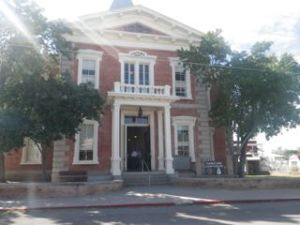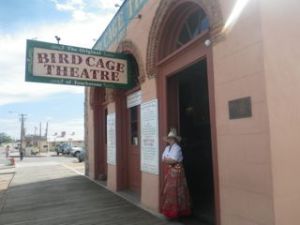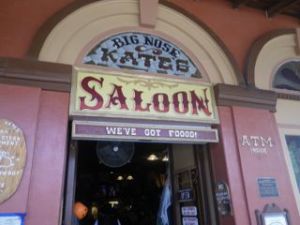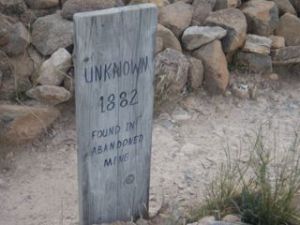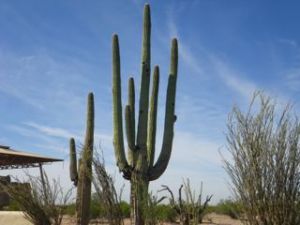I am really into the history of the Wild West and the characters that inhabited it. So you would think that visiting Tombstone was a must for me. Not in the least. Afraid of a tourist trap, even copious numbers of people telling me to go there weren’t enough to make me believe that this iconic western town would be worth a detour. If it hadn’t been kinda sorta on the way to Nogales from Tucson, I would have definitely given it a pass.
I spent an enjoyable day there and do not regret going, but I feel that my initial misgivings stand. Lots of fun can be had in Tombstone and if you’re a history buff you’ll get your fill of artifacts, but if you want a more genuine-feeling Wild West town experience there are lots of better choices.
Before I get into my narrative about the day, I have to explain the lack of pictures. You can take as many pictures as you want in Tombstone of anything, but you cannot post anything about paid attractions online without express written permission, which is apparently difficult to get. So you’ll just have to take my word for a lot of this. 🙂
My first stop was the courthouse museum, admission $5. It was full of history about Tombstone and its colourful inhabitants.
I learned about the card game faro, the most popular game at the time, but which is now outlawed in the US because it gives the house a 67% chance of winning.
One of the more ghastly exhibits was a reconstruction of the gallows. I believe they are the second gallows I have ever seen (the first being in Ottawa!), and let’s just say they’re not nice to look at. 🙂
I learned about a Chinese man who was born in Virginia City, MT, where I was just recently, and the Chinese population of the town.
One exhibit that I found quite impressive was two large walls full of all sorts of different types of barbed wire. I didn’t realise that many exist!
The courthouse museum was a good start to my day. I then headed for Allen Street, the main kitschy touristy drag with a faux Western look (go to Dawson City for a more realistic one!) and lots of shops selling tchotkes.
I encountered a man who loves the outdoors and doesn’t let his physical disabilities stop him from going off the beaten path. Picture taken with permission!
My next stop was the Bird Cage Theatre, admission $10.
This was a theatre/brothel/gambling hall/saloon that operated from 1881 to 1889 and has been preserved intact, one of the few original Tombstone buildings that survived the fires. Admission gives you all the time you want to wander the rooms. This was a wow experience for me. So much history, and preserved almost exactly as it was 125 years ago! I was able to use the incredible zoom feature in my camera to see details in the wallpaper of the viewing balconies and details of the ceiling.
The Bird Cage Theatre was totally worth the admission price also. Buoyed by my success thus far at avoiding tourist traps, I took the plunge and went to check out Big Nose Kate’s Saloon, named after Doc Holliday’s girlfriend. The saloon was once the Grand Hotel.
The saloon was a little loud, but the music was good old classic country sung by a lively entertainer, so I decided to stay for a bit. I ordered a beer and perused the menu. The food was really inexpensive (!), so I decided to try their ‘Stampede’ burger, with cheese, bacon, and BBQ sauce. Surprise, the burger was excellent and they even made frozen fries taste good somehow! I tipped the server and singer generously, and still came out of there at less than $20 for a beer, lunch, and a show!
Before I left, I took the twisty stairs down to the basement into yet another shop so I could see the room of the man who did menial labour at the hotel and tunneled his way from his room into a silver mine in his downtime. Seriously!
Yup, my day was going well! So well, in fact, that I decided to jump into the tourist trap and buy a ticket to see a recreation of the OK Corral gunfight. I ponied up $10 and for that got to see the show, the OK Corral museum, the Tombstone history movie, and I got a free copy of a reproduction of the Tombstone Epitaph newspaper with the article about the shootout and subsequent inquest!
The gunfight show was amusing. The acting wasn’t great and I thought that it was hilarious that they cast an old guy to play Billy Clanton, who was 19 when he died at the hands of the Earps. What I got from the show was a better sense of the unvarnished truth about the fight and where it happened exactly. One of the most memorable parts of this whole part of the day was seeing the map Wyatt Earp drew in the 1920s showing what he remembered about the placement of people during the fight. He had bad handwriting!
The movie dated back to the 1950s and was narrated by Vincent Price! It was a little bizarre in that most of the action was in a diorama and occasionally a screen would come down to show reenactments of certain things. I learned a lot about the history of the town. The founder was told when he went to the area that he would only find his tombstone, hence the name he picked for the settlement!
I have to say that I find it distasteful that there’s a sign on Allen Street at the back of the corral saying that the fight happened there when the true location is on now super busy Fremont Street, several doors down from the corral. There’s a sign there, too, but I think a lot of people would miss it. I only knew to look for the spot because of my own knowledge of the event.

The real site of the OK Corral gunfight. There’s just a little sign next to Fly’s photography studio and boarding house.
I went to the actual fight site while munching on an ice cream, found for just $2 for a decent-sized cone. When I was done with that, I went to the Epitaph office to pick up my free paper. By the way, I love the name of that newspaper!
There is a free exhibit in the newspaper office about the man who founded it and quite a lot of history about his and Wyatt Earp’s connection to the Chilkoot Trail and the Klondike gold fields!
My free paper would have cost me $3 and I would have bought one, so I really got my money’s worth out of that OK Corral show ticket!
My final stop of the day was the Boothill Cemetery. Access is free through yet another gift shop. I paid the $3 to get the booklet that gives info about all the graves.
I was surprised to find Tombstone to be relatively inexpensive and good value if you spend your money carefully. I never once felt that I was paying a ‘Tombstone tax’, a premium just because of the location.
I’m glad I went to Tombstone and found the experience worthwhile, but this wasn’t a wow day for me at all. What I enjoyed most were the artifacts. I’d say the two best parts of the day were my first steps into the Bird Cage Theatre and seeing Wyatt Earp’s gunfight map!
Two pictures from the trip to Nogales:

